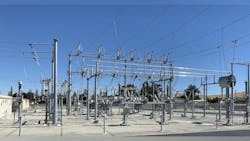Silicon Valley Utilities Gird for Surging Energy Demand Fed by New Data Centers
An investor presentation sharing earnings results delivered on June 12 by Pacific Gas and Electric Company (PG&E Corporation), one of the foremost natural gas and electric utilities for residential and business customers in northern and central California, mentions several large data center projects among 3.5 gigawatts (GW) of booked demand for electricity reported for the sector.
As indicative of the spike in Silicon Valley power demand linked to AI compute, large projects by unnamed customers in PG&E's data project pipeline, noted on slide 21 of the company's presentation (which adds up coming demand from more than two dozen newly planned facilities) include an 800 MW project slated for for Hayward, California in 2028, as well as requirements for 600 MW and 500 MW data centers in San Jose.
PG&E said more than half of the slated additional data center capacity will be located in the San Jose area.
SVP Considerations
Part of what's notable about the 3.5 MW of demand in PG&E's data center project pipeline - roughly more than the output of three traditional nuclear power plants, as a recent report from Bloomberg notes - is that it doesn’t include Santa Clara, which is served by competitive utility service provider Silicon Valley Power (SVP).
Especially in light of the planned projects mentioned above, Bloomberg's report emphasizes how "the San Francisco Bay Area is one of the eight primary data center markets in the US, given its proximity to the headquarters of global technology giants that include the likes of Meta Platforms, Alphabet, and Apple."
Importantly, a May 2023 brief from CBRE indicated how SVP has been challenged by delays in bringing on new substations, noting how many of Silicon Valley's "substation sites will not be energized until 2028-2029 and their timing for coming online may be delayed due to the grid capacity being maxed out in Santa Clara."
CBRE's brief also pointed out how SVP, as Santa Clara’s municipal utility provider, is making improved power generation a top priority to address these challenges.
CBRE stated:
"SVP has committed to eventually procure new energy only from renewable and/or greenhouse-gas-free sources: 50% renewable energy by 2026, 60% renewable energy by 2030 and greenhouse gas-free supply by 2045. An early adopter of wind power, SVP began investing in wind farms in the early 1980s. Today, SVP generates hydroelectric and solar power across California and Washington."
Rounding out the picture, previous reporting by Datacenter Dynamics noted how SVP’s planned outlook in Santa Clara includes a mix of energies, including substantial stakes in geothermal and battery methods to meet a data center load expected to double by 2035.
Don't Sleep on CA EV Demand
Because this story is happening in California, the power requirements for electric vehicle (EV) adoption are also significant.
In its above-cited presentation, PG&E anticipates more demand from EVs than data centers.
As diversified contributors to total load growth in terawatt hours (TWh), PG&E's presentation has EVs pegged at a compound annual growth rate (CAGR) of 1.25% - 2%, with data centers accounting for 0.5% - 1.5%, and building electrification with 0.25% - 0.5%.
Bloomberg's report affirmed, "PG&E said the total electricity demand on its system is expected to grow as much a 2% to 4% annually through 2040. In addition to data centers, electric cars, and increasingly electrified buildings are driving the uptick."
Data Center AI Boom, Power Crunch Reverberates Across U.S., Calls Up Nuclear Stakes
Tangentially worth noting as a guidepost for the extent of national electricity demand, also via Bloomberg, renewable energy specialist NextEra Energy now says it is getting requests for as much as 5 GWs of power from data center customers.
NextEra told Bloomberg that technology companies are so desperate to build massive data centers in the U.S. that they’re asking the clean-energy giant to find them locations with enough electricity to power entire cities.
“We’ve had some come to us and say, ‘Can you show us sites that can accommodate 5 gigawatts of demand?’” John Ketchum, Florida-based NextEra’s CEO, said in an interview with Bloomberg News in New York.
“Think about that," he said. "That’s the size of powering the city of Miami.” Ketchum declined to name the companies to Bloomberg.
In the report, NextEra's Ketchum also revealed that he’s had inquiries from potential data center customers that could be interested in taking advantage of the 600 MW Duane Arnold reactor.
Located in Palo, Iowa, Duane Arnold is the state's only nuclear power plant. “I would consider it, if it could be done safely and on budget,” said Ketchum.
The NextEra Energy chief's speculation apparently arrives not a moment too soon. Among hyperscalers in recent years as previously reported by DCF, Apple, Google and Meta are all known for having invested billions of dollars, with plans for millions of square feet in Iowa data centers.
About the Author
Matt Vincent
A B2B technology journalist and editor with more than two decades of experience, Matt Vincent is Editor in Chief of Data Center Frontier.



